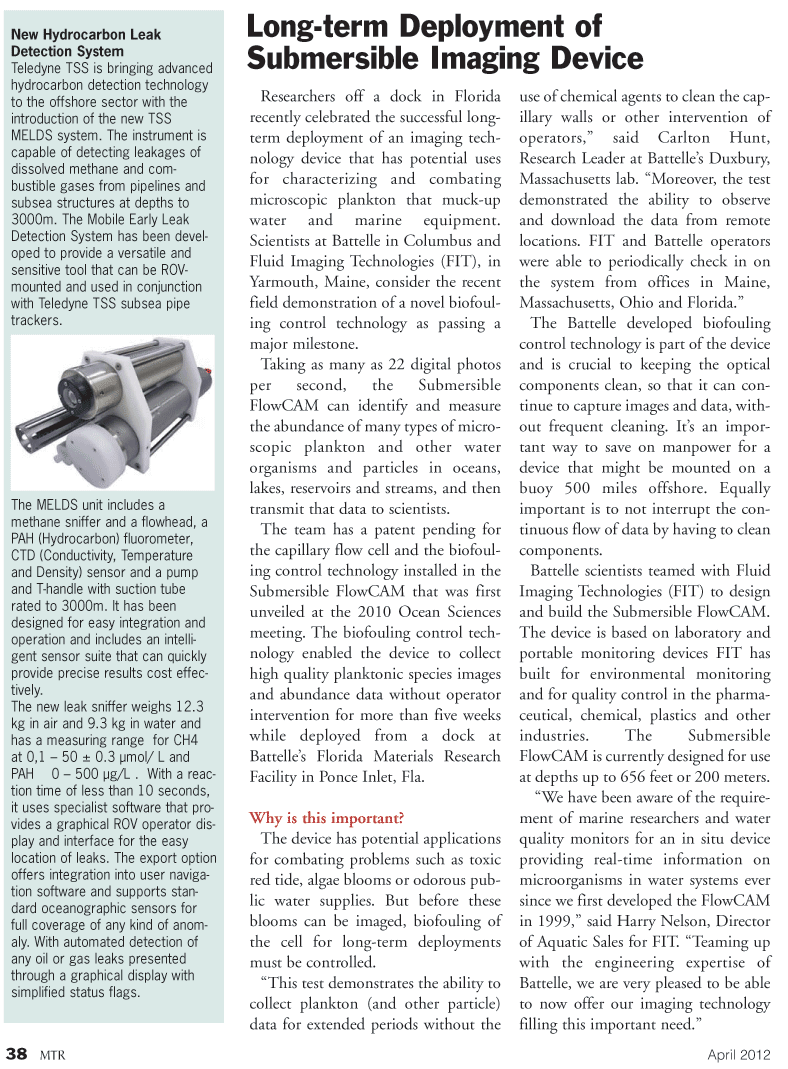
Page 38: of Marine Technology Magazine (April 2012)
Global Offshore Deepwater Report
Read this page in Pdf, Flash or Html5 edition of April 2012 Marine Technology Magazine
38MTRApril 2012Researchers off a dock in Florida recently celebrated the successful long- term deployment of an imaging tech- nology device that has potential usesfor characterizing and combatingmicroscopic plankton that muck-up water and marine equipment.Scientists at Battelle in Columbus and Fluid Imaging Technologies (FIT), in Yarmouth, Maine, consider the recent field demonstration of a novel biofoul- ing control technology as passing a major milestone.Taking as many as 22 digital photos per second, the Submersible FlowCAM can identify and measure the abundance of many types of micro- scopic plankton and other waterorganisms and particles in oceans, lakes, reservoirs and streams, and then transmit that data to scientists.The team has a patent pending forthe capillary flow cell and the biofoul- ing control technology installed in the Submersible FlowCAM that was first unveiled at the 2010 Ocean Sciences meeting. The biofouling control tech- nology enabled the device to collecthigh quality planktonic species imagesand abundance data without operatorintervention for more than five weeks while deployed from a dock at Battelles Florida Materials Research Facility in Ponce Inlet, Fla. Why is this important? The device has potential applicationsfor combating problems such as toxic red tide, algae blooms or odorous pub- lic water supplies. But before these blooms can be imaged, biofouling ofthe cell for long-term deployments must be controlled. This test demonstrates the ability to collect plankton (and other particle) data for extended periods without theuse of chemical agents to clean the cap-illary walls or other intervention of operators,? said Carlton Hunt, Research Leader at Battelles Duxbury, Massachusetts lab. Moreover, the test demonstrated the ability to observe and download the data from remote locations. FIT and Battelle operators were able to periodically check in on the system from offices in Maine, Massachusetts, Ohio and Florida.? The Battelle developed biofouling control technology is part of the device and is crucial to keeping the optical components clean, so that it can con-tinue to capture images and data, with- out frequent cleaning. Its an impor- tant way to save on manpower for a device that might be mounted on abuoy 500 miles offshore. Equally important is to not interrupt the con- tinuous flow of data by having to clean components.Battelle scientists teamed with Fluid Imaging Technologies (FIT) to design and build the Submersible FlowCAM. The device is based on laboratory and portable monitoring devices FIT has built for environmental monitoring and for quality control in the pharma- ceutical, chemical, plastics and otherindustries. The Submersible FlowCAM is currently designed for use at depths up to 656 feet or 200 meters.We have been aware of the require- ment of marine researchers and water quality monitors for an in situ deviceproviding real-time information on microorganisms in water systems ever since we first developed the FlowCAM in 1999,? said Harry Nelson, Director of Aquatic Sales for FIT. Teaming up with the engineering expertise of Battelle, we are very pleased to be able to now offer our imaging technology filling this important need.? Long-term Deployment ofSubmersible Imaging DeviceNew Hydrocarbon Leak Detection SystemTeledyne TSS is bringing advanced hydrocarbon detection technology to the offshore sector with the introduction of the new TSS MELDS system. The instrument iscapable of detecting leakages ofdissolved methane and com-bustible gases from pipelines and subsea structures at depths to 3000m. The Mobile Early LeakDetection System has been devel-oped to provide a versatile and sensitive tool that can be ROV-mounted and used in conjunctionwith Teledyne TSS subsea pipe trackers. The MELDS unit includes amethane sniffer and a flowhead, a PAH (Hydrocarbon) fluorometer, CTD (Conductivity, Temperature and Density) sensor and a pumpand T-handle with suction tube rated to 3000m. It has beendesigned for easy integration andoperation and includes an intelli-gent sensor suite that can quicklyprovide precise results cost effec- tively. The new leak sniffer weighs 12.3 kg in air and 9.3 kg in water andhas a measuring range for CH4 at 0,1 ? 50 ± 0.3 µmol/ L andPAH 0 ? 500 µg/L . With a reac- tion time of less than 10 seconds,it uses specialist software that pro- vides a graphical ROV operator dis-play and interface for the easy location of leaks. The export option offers integration into user naviga- tion software and supports stan- dard oceanographic sensors for full coverage of any kind of anom-aly. With automated detection of any oil or gas leaks presented through a graphical display with simplified status flags.

 37
37

 39
39
